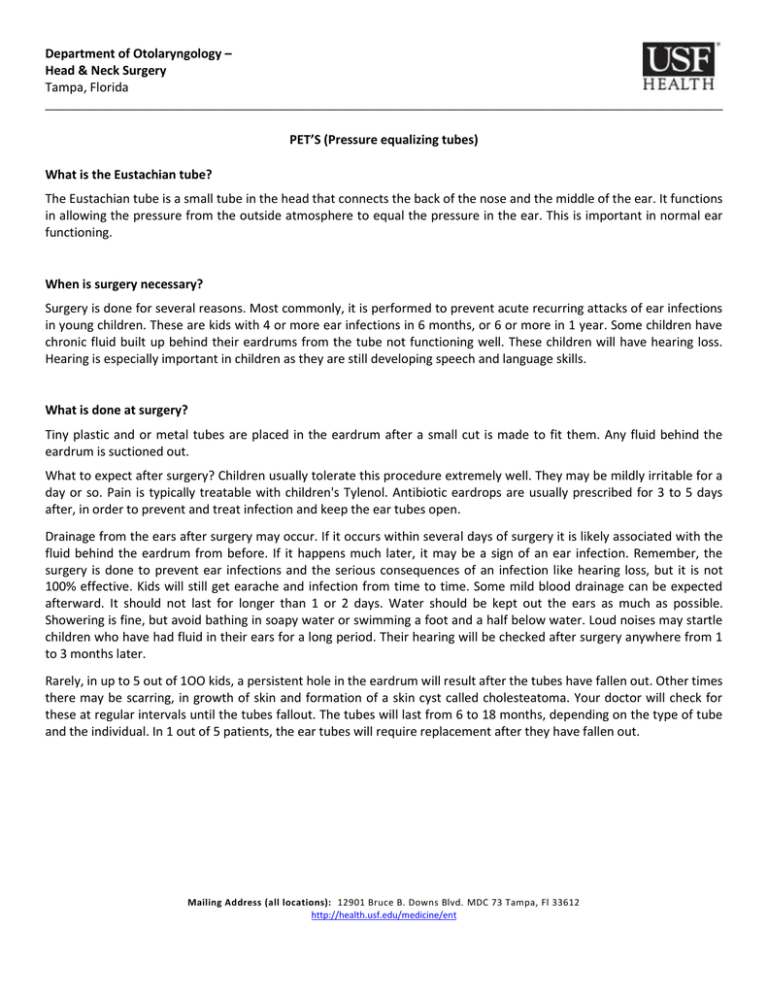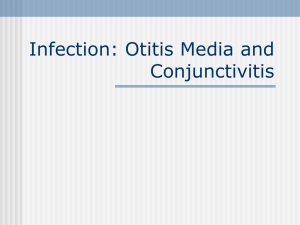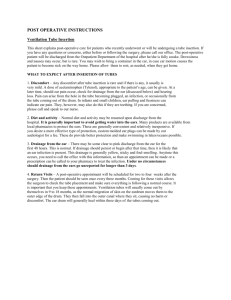Surgery - USF Health Otolaryngology PET
advertisement

Department of Otolaryngology – Head & Neck Surgery Tampa, Florida __________________________________________________________________________________________ PET’S (Pressure equalizing tubes) What is the Eustachian tube? The Eustachian tube is a small tube in the head that connects the back of the nose and the middle of the ear. It functions in allowing the pressure from the outside atmosphere to equal the pressure in the ear. This is important in normal ear functioning. When is surgery necessary? Surgery is done for several reasons. Most commonly, it is performed to prevent acute recurring attacks of ear infections in young children. These are kids with 4 or more ear infections in 6 months, or 6 or more in 1 year. Some children have chronic fluid built up behind their eardrums from the tube not functioning well. These children will have hearing loss. Hearing is especially important in children as they are still developing speech and language skills. What is done at surgery? Tiny plastic and or metal tubes are placed in the eardrum after a small cut is made to fit them. Any fluid behind the eardrum is suctioned out. What to expect after surgery? Children usually tolerate this procedure extremely well. They may be mildly irritable for a day or so. Pain is typically treatable with children's Tylenol. Antibiotic eardrops are usually prescribed for 3 to 5 days after, in order to prevent and treat infection and keep the ear tubes open. Drainage from the ears after surgery may occur. If it occurs within several days of surgery it is likely associated with the fluid behind the eardrum from before. If it happens much later, it may be a sign of an ear infection. Remember, the surgery is done to prevent ear infections and the serious consequences of an infection like hearing loss, but it is not 100% effective. Kids will still get earache and infection from time to time. Some mild blood drainage can be expected afterward. It should not last for longer than 1 or 2 days. Water should be kept out the ears as much as possible. Showering is fine, but avoid bathing in soapy water or swimming a foot and a half below water. Loud noises may startle children who have had fluid in their ears for a long period. Their hearing will be checked after surgery anywhere from 1 to 3 months later. Rarely, in up to 5 out of 1OO kids, a persistent hole in the eardrum will result after the tubes have fallen out. Other times there may be scarring, in growth of skin and formation of a skin cyst called cholesteatoma. Your doctor will check for these at regular intervals until the tubes fallout. The tubes will last from 6 to 18 months, depending on the type of tube and the individual. In 1 out of 5 patients, the ear tubes will require replacement after they have fallen out. Mailing Address (all locations): 12901 Bruce B. Downs Blvd. MDC 73 Tampa, Fl 33612 http://health.usf.edu/medicine/ent



